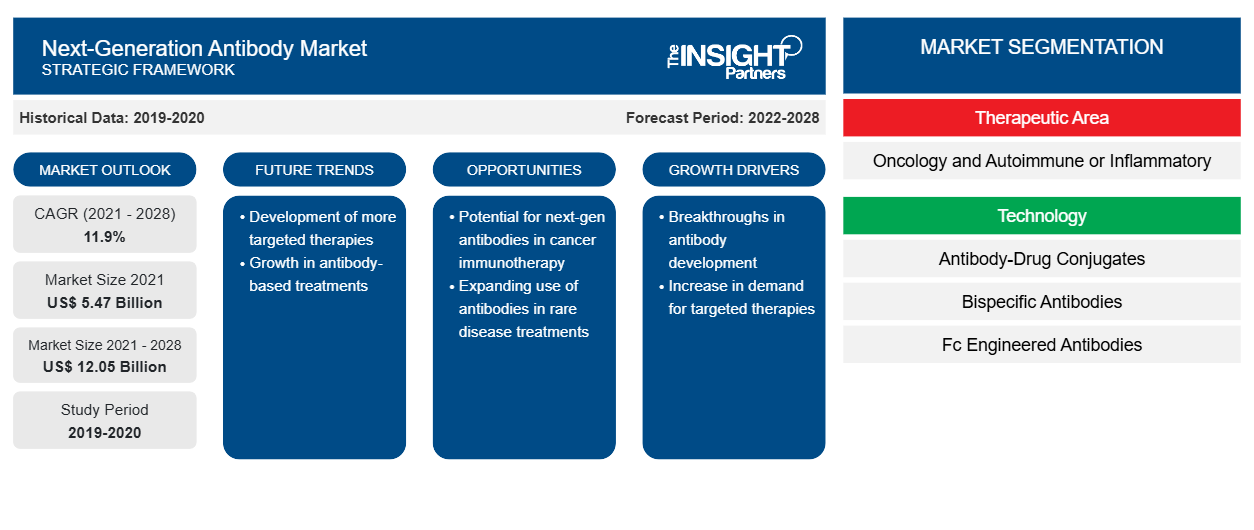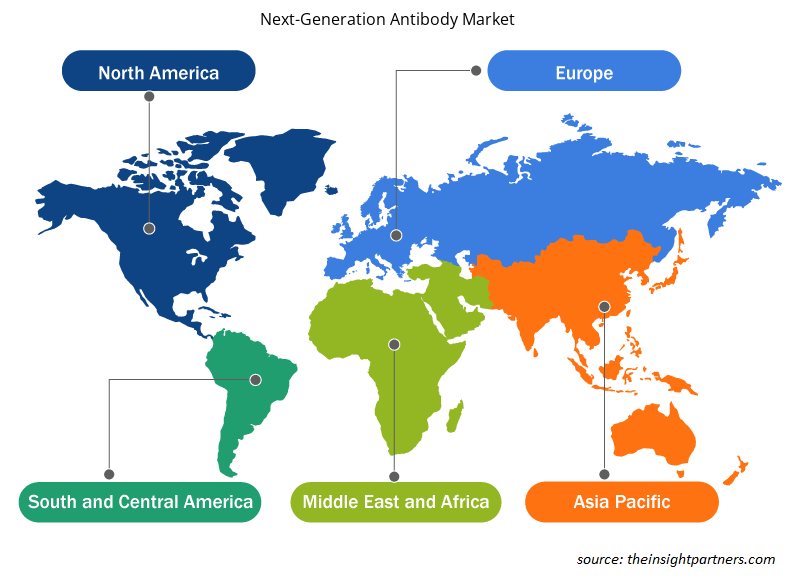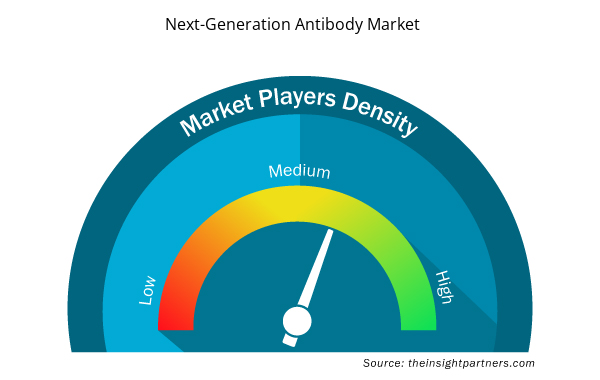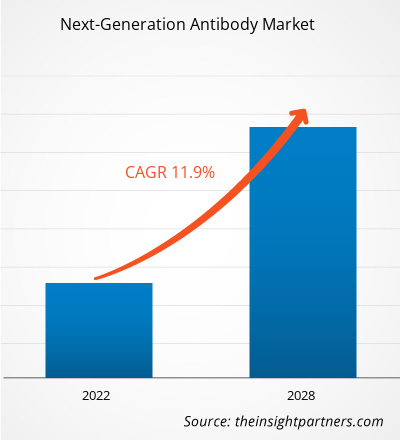The next-generation antibody market is expected to reach US$ 12,050.13 million by 2028 from US$ 5,468.41 million in 2021; it is estimated to grow at a CAGR of 11.9% from 2021 to 2028.
Next-generation antibodies are designed to be more specific and often more potent than traditional monoclonal antibodies. Next-generation antibody strategies are required to engineer a useful therapeutic combining antibody, payload, linker, and conjugation method while ensuring stability, targeted delivery, and limited off-target effects.
The report offers insights and in-depth analysis of the next-generation antibody market, emphasizing various parameters such as market trends, technological advancements, market dynamics, and competitive landscape analysis of leading market players worldwide. It also includes the impact of the COVID-19 pandemic on the market across all the regions. The pandemic has disrupted the socioeconomic conditions of various countries across the world. Presently, the US is the world's worst-affected country due to the COVID-19 outbreak with the highest number of confirmed cases and deaths across the world, as per the recent WHO statistics. The high number of COVID-19 positive cases has negatively impacted the global economies. There has been a decline in overall business activities and the growth of various industries operating worldwide.
Customize This Report To Suit Your Requirement
You will get customization on any report - free of charge - including parts of this report, or country-level analysis, Excel Data pack, as well as avail great offers and discounts for start-ups & universities
Next-Generation Antibody Market: Strategic Insights

- Get Top Key Market Trends of this report.This FREE sample will include data analysis, ranging from market trends to estimates and forecasts.
You will get customization on any report - free of charge - including parts of this report, or country-level analysis, Excel Data pack, as well as avail great offers and discounts for start-ups & universities
Next-Generation Antibody Market: Strategic Insights

- Get Top Key Market Trends of this report.This FREE sample will include data analysis, ranging from market trends to estimates and forecasts.
The COVID-19 outbreak has put an immense burden on healthcare infrastructure in the US, Canada, and Mexico. In addition, most pharmaceutical and biotechnological companies and research institutes are engaged in developing COVID-19 vaccines and drugs. Both set pharmaceutical companies and small startups have come forward to advance treatments and vaccines that target the infection created by the novel coronavirus. As a result, vaccine-related research activities in pharmaceutical and biotechnology companies, research centers, and educational research institutes are acknowledged essential and have been primarily unaffected in operations and output. However, due to the rise in research activities, both the accessibility of funding for analysis and the need for antibodies, including next-generation antibodies, are anticipated to grow. In addition, at the lead of the COVID-19 outbreak, many researchers worldwide are involved in the viral examination of SARS-CoV-2, the virus that develops COVID-19. For both vaccines and therapeutics, the antibodies generated are examined for their functional efficiency to counterbalance the target virus. Therefore, the COVID-19 pandemic is expected to positively impact the next-generation antibody market in the coming years.
Based on region, the next-generation antibody market is segmented into North America, Europe, Asia Pacific, the Middle East & Africa, and South and Central America.
Market Insights
Growing Demand for Next-Generation Antibody Therapeutics to Drive Next-Generation Antibody Market
Rising developments in biotechnology have led to an increasing acceptance for next-generation antibodies therapeutics, which is driving its use in autoimmune, inflammatory, and chronic diseases treatment. Next-generation antibody treatments have resulted from the application of sophisticated technologies in antibody therapeutics, such as antibody–drug conjugates (ADCs), glycoengineered antibodies, and specific antibodies (BsAbs). Therefore, applications of next-generation antibodies are being widely studied to treat various chronic diseases such as cancer, HIV, infectious diseases etc. The rising demand for these antibodies have resulted in the rapid increase in the approval of ADCs and other next-generation antibodies therapeutics. For instance, in May 2020, Takeda Pharmaceutical Company Limited announced the FDA approval of ALUNBRIG (brigatinib) for adult patients with anaplastic lymphoma kinase-positive (ALK+) metastatic non-small cell lung cancer (NSCLC) as detected by an FDA-approved test. ALUNBRIG's current indication has been expanded to encompass the first-line setting with its approval. ALUNBRIG is a next-generation tyrosine kinase inhibitor (TKI) designed to target ALK molecular abnormalities. Similarly, in 2019, Genentech announced FDA accelerated approval of Polatuzumab vedotin-piiq, a CD79b-directed antibody-drug conjugate indicated in combination with bendamustine and a rituximab product for adult patients with relapsed or refractory diffuse large B-cell lymphoma.
Therefore, the next-generation antibody market is anticipated to grow rapidly during the forecast period due to the rising clinical trials approvals and high adoption of next-generation antibodies therapeutics for the treatment of various diseases.
Therapeutic Area-Based Insights
Based on therapeutic area, the next-generation antibody market is bifurcated into oncology and autoimmune or inflammatory. The oncology segment accounted for a larger share of the market.
Technology-Based Insights
Based on technology, the next-generation antibody market is segmented into antibody-drug conjugates, bispecific antibodies, Fc engineered antibodies, antibody fragments & antibody-like proteins, and biosimilar antibody products. The antibody-drug conjugates segment held the largest share of the market in 2021, and the same segment is estimated to register the highest CAGR of 12.1% in the market during the forecast period.
The next-generation antibody market players adopt various organic strategies, such as product launch and expansion, to expand their footprint and product portfolio worldwide and meet the growing demand.
Next-Generation Antibody Market Regional Insights
The regional trends and factors influencing the Next-Generation Antibody Market throughout the forecast period have been thoroughly explained by the analysts at Insight Partners. This section also discusses Next-Generation Antibody Market segments and geography across North America, Europe, Asia Pacific, Middle East and Africa, and South and Central America.

- Get the Regional Specific Data for Next-Generation Antibody Market
Next-Generation Antibody Market Report Scope
| Report Attribute | Details |
|---|---|
| Market size in 2021 | US$ 5.47 Billion |
| Market Size by 2028 | US$ 12.05 Billion |
| Global CAGR (2021 - 2028) | 11.9% |
| Historical Data | 2019-2020 |
| Forecast period | 2022-2028 |
| Segments Covered |
By Therapeutic Area
|
| Regions and Countries Covered | North America
|
| Market leaders and key company profiles |
Next-Generation Antibody Market Players Density: Understanding Its Impact on Business Dynamics
The Next-Generation Antibody Market is growing rapidly, driven by increasing end-user demand due to factors such as evolving consumer preferences, technological advancements, and greater awareness of the product's benefits. As demand rises, businesses are expanding their offerings, innovating to meet consumer needs, and capitalizing on emerging trends, which further fuels market growth.
Market players density refers to the distribution of firms or companies operating within a particular market or industry. It indicates how many competitors (market players) are present in a given market space relative to its size or total market value.
Major Companies operating in the Next-Generation Antibody Market are:
- F. HOFFMANN-LA ROCHE LTD.
- Kyowa Kirin Co., Ltd.
- Seagen Inc.
- ImmunoGen, Inc.
- Takeda Pharmaceutical Company Limited
Disclaimer: The companies listed above are not ranked in any particular order.

- Get the Next-Generation Antibody Market top key players overview
Company Profiles
- F. HOFFMANN-LA ROCHE LTD.
- Kyowa Kirin Co., Ltd.
- Seagen Inc.
- ImmunoGen, Inc.
- Takeda Pharmaceutical Company Limited
- Amgen Inc.
- Pfizer Inc.
- Catalent Inc
- AstraZeneca
- Xencor
- Historical Analysis (2 Years), Base Year, Forecast (7 Years) with CAGR
- PEST and SWOT Analysis
- Market Size Value / Volume - Global, Regional, Country
- Industry and Competitive Landscape
- Excel Dataset


- Retinal Imaging Devices Market
- Point of Care Diagnostics Market
- Hydrogen Storage Alloys Market
- Health Economics and Outcome Research (HEOR) Services Market
- Broth Market
- Saudi Arabia Drywall Panels Market
- Terahertz Technology Market
- Joint Pain Injection Market
- Bioremediation Technology and Services Market
- Workwear Market

Report Coverage
Revenue forecast, Company Analysis, Industry landscape, Growth factors, and Trends

Segment Covered
Therapeutic Area, and Technology

Regional Scope
North America, Europe, Asia Pacific, Middle East & Africa, South & Central America

Country Scope
Argentina, Australia, Brazil, Canada, China, France, Germany, India, Italy, Japan, Mexico, Saudi Arabia, South Africa, South Korea, Spain, United Arab Emirates, United Kingdom, United States
Frequently Asked Questions
What is the market CAGR value of the next-generation antibody market during the forecast period?
The global next-generation antibody market is expected to reach US$ 5,428.41 million in 2028 from US$ 12,050.13 million in 2021. The market is estimated to grow with a CAGR of 11.9% from 2021-2028.
Which is the therapeutic area where the next-generation antibodies are often used?
The next-generation antibodies are used in the therapeutic areas- oncology and oncology, and autoimmune or inflammatory. Mostly, the next-generation antibodies are used in the oncology field. The oncology segment is likely to hold the largest share of the market in 2021. Moreover, the oncology segment is anticipated to register the highest CAGR in the market during the forecast period, due to the vast usage of next-generation antibodies for cancers, high volume consumption, and product innovation for this field
Who are the key players in the next-generation antibody market?
The disposable pipettes tips market majorly consists of players like F. HOFFMANN-LA ROCHE LTD., Kyowa Kirin Co., Ltd., Seagen Inc., ImmunoGen, Inc., Takeda Pharmaceutical Company Limited, Amgen Inc., Pfizer Inc., Catalent Inc, AstraZeneca, and Xencor among others.
What are the drivers and restraints for the next-generation antibody market?
The growth of the market is attributed to the increasing prevalence of cancer and growing demand for next-generation antibody therapeutics drives the market growth. However, the complications associated with the manufacturing and approvals hampers the market growth.
Which is the potential market for next-generation antibodies in terms of the region?
The Asia Pacific registered as the fastest-growing region in the global next-generation antibody market. The market in this region is expected to grow significantly in countries such as China, Japan, and India. The market is driven by growing investments from international players in China and India, improving government support in countries such as China, expanding R&D, and advancing healthcare infrastructure. Therefore, the region holds huge potential for the next-generation antibody market players to grow during the forecast period.
Trends and growth analysis reports related to Life Sciences : READ MORE..
The List of Companies - Next-generation Antibody Market
- F. HOFFMANN-LA ROCHE LTD.
- Kyowa Kirin Co., Ltd.
- Seagen Inc.
- ImmunoGen, Inc.
- Takeda Pharmaceutical Company Limited
- Amgen Inc.
- Pfizer Inc.
- Catalent Inc
- AstraZeneca
- Xencor

 Get Free Sample For
Get Free Sample For